Joe@NextLevelDetail
New member
- Jun 4, 2015
- 1,929
- 0
Your Most Expensive Investment
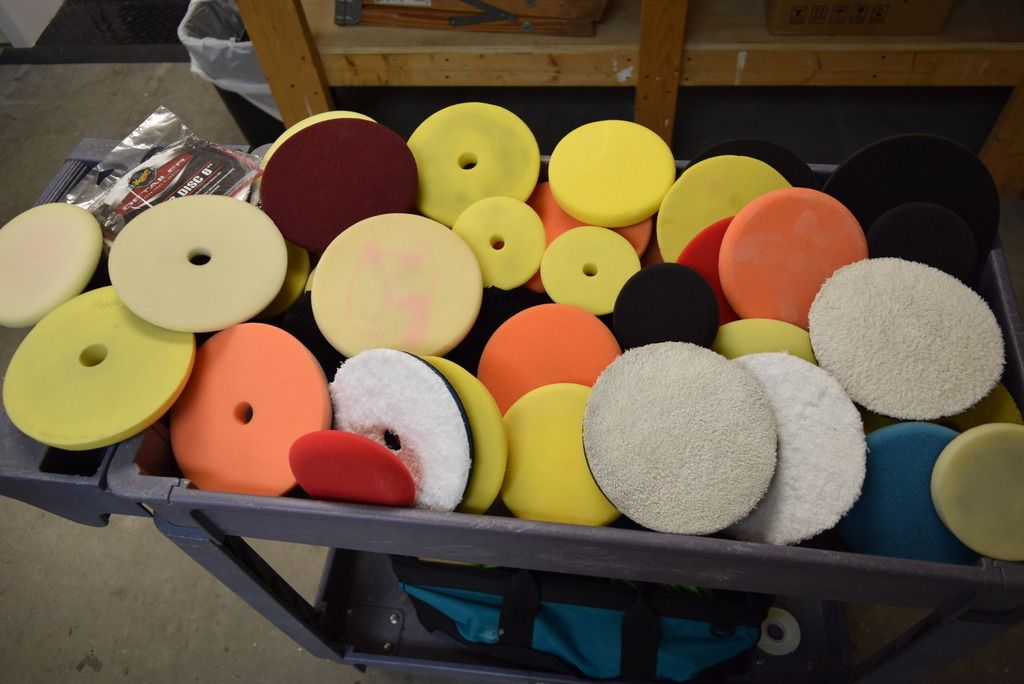
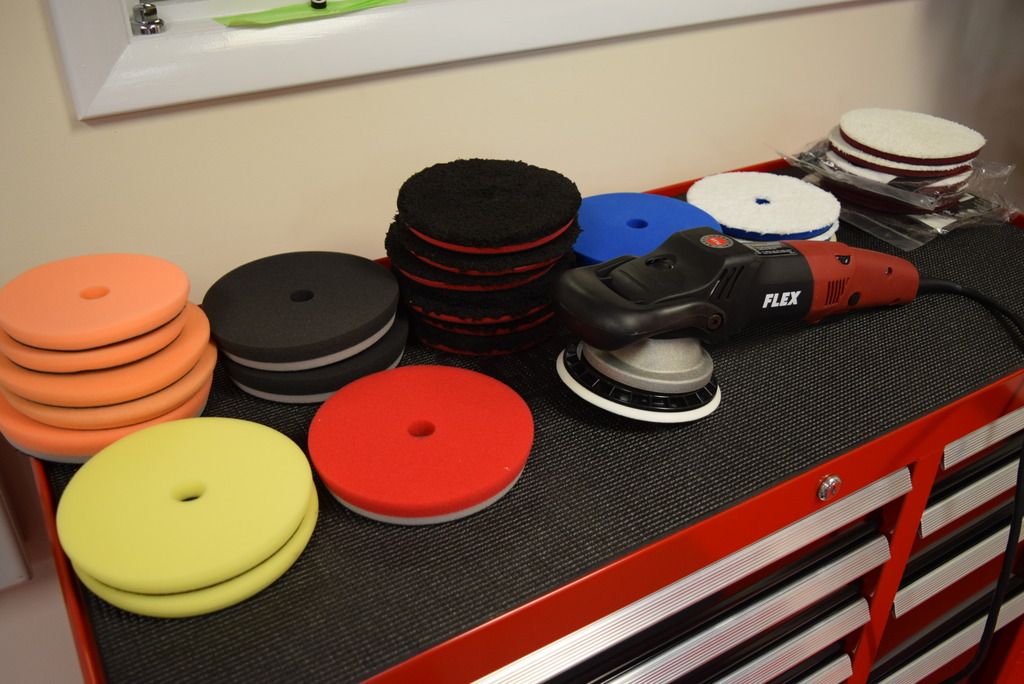
You might be thinking that tool's are your most expensive investment, But in reality its not, Tools require little maintenance after purchase. As for pads you will always go through more and more. The above photo you will notice a Flex polisher, and pads surrounding. The Flex polisher is $389 the pads I have placed around the polisher add up to a value of $400! and in reality that is a small fraction of all the pads I own, And it is crazy when you stop and think that only 25 pads+ accumulate to that value.
Pads are one of the most important and costly materials a detailer uses. So how you take care of them is vital to longevity and performance.
As a professional detailer I am always looking for ways to cut costs, My concerns with spending more money really cost me more cash in the long run. In my professional career there is nothing more frustrating then a pre mature pad failure. Through my experience I have became to realize that it's how you care for your pads that determines the life span.
Maintaining Pads
There is more to cleaning your pads than "cleaning your pads" We have all been guilty of using, Dish Soap, Degreaser, All Purpose Cleaner. There are even alot of mentions on this very forum about paint thinner. And all of those products will get the job done in cleaning your pads, However these powerful harmful products are actually damaging and degrading your pads with each use. Naturally us being detailers we want everything 100% clean, However we are being counter intuitive, Those stubborn polishing stains are not going to affect polishing performance, However the wrong chemicals, that we are using to remove those stubborn stains damage the foam cell foundation and that will most certainly alter your polishing pad performance and life span.
Ever notice after you use dish soap to strip a car how grabby and squeaky the paint feels? The same affect happens to your polishing pads after using the above cleaners, It makes your pad feel dry, brittle, grabby, and the foam feels squeaky.
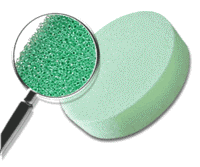
The above photo you will see the foam cells magnified, You will notice the honey comb cell pattern, and that is the structural foundation of the pad. All Purpose Cleaners, Degreasers, Dish Soap, Laundry Soap, all load up in the pores and cells of these pads and actually dissolve the pores, And this is a one way ticket to pad failure. Residue from all the cleaners above will linger in the pad and continue to break down as you use it. So now it is taking a beating while getting polished and cleaned.
The Right Chemical For The Job
All soap is not created equally, Using the correct chemical for any maintenance is key, We use car soap and rinseless wash solutions to maintain our paint finish, that was designed and formulated for paint, None of us would ever use laundry soap to wash our car. , However every soap was formulated for a different purpose, We wouldnt use hair shampoo for laundry, Laundry soap for body wash, and dish soap for shampoo, sure it would give us a end result of "clean" however there would be certain things that can potentially cause damage or not work as well.
Have you ever went camping or ran out of shampoo and had to use body wash to clean there hair? Afterwards it leaves you with a very dry and grabby feel, Another great example is using degreaser or all purpose cleaner to wash our hands, afterwards they feel very dry that is why we use hand soap, The same theory goes for polishing pads. Chemist formulate and design every product to do what its intended purpose was for, Polishing pad cleaner is designed to remove compounds, polishes, waxes/sealant, specifically for foam.
Cleaning Your Pads
Not only can the strong chemicals hurt your pads, but the actual way you clean them can degrade them as well.

spray your polishing pad cleaner on your pads, im using McKees 37 Polishing Pad Cleaner.

After you let the product sit on the pads for 20-30 seconds, Get a SOFT brush not a hard brush and agitate the compound/polish
(using a hard brush can cause ripples in the pad)
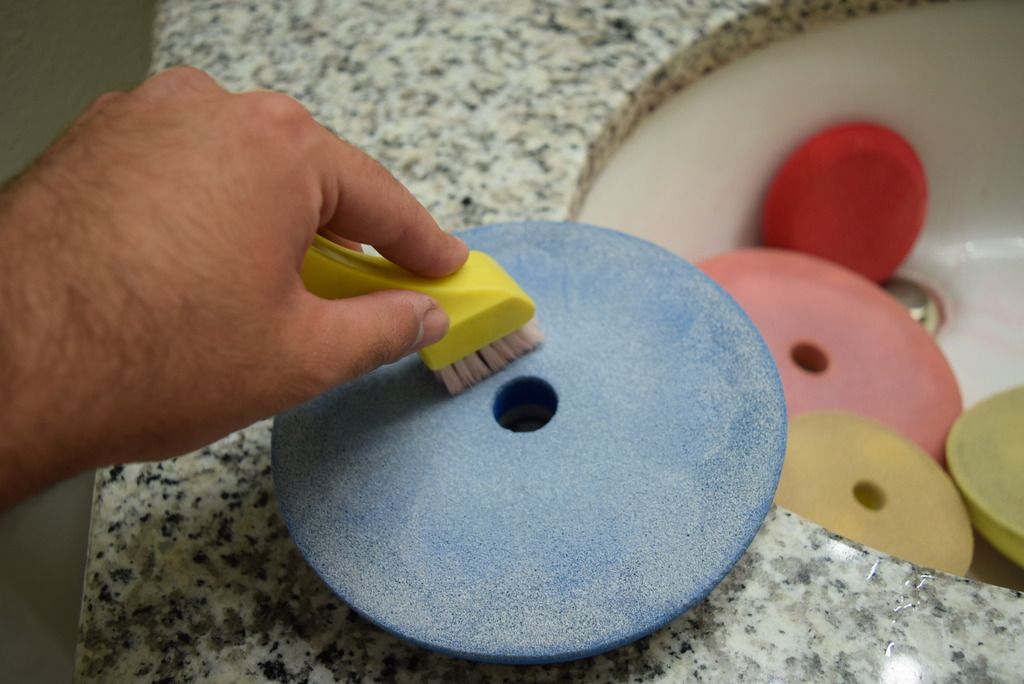
Using cool/warm water I run the pad under the water while brushing face of the pad with my brush, Ensuring all polish is out of the pad.
(do not use really hot water as this can cause damage to your pad, You want to cool the pad down so the foam cells can expand and get stong again)
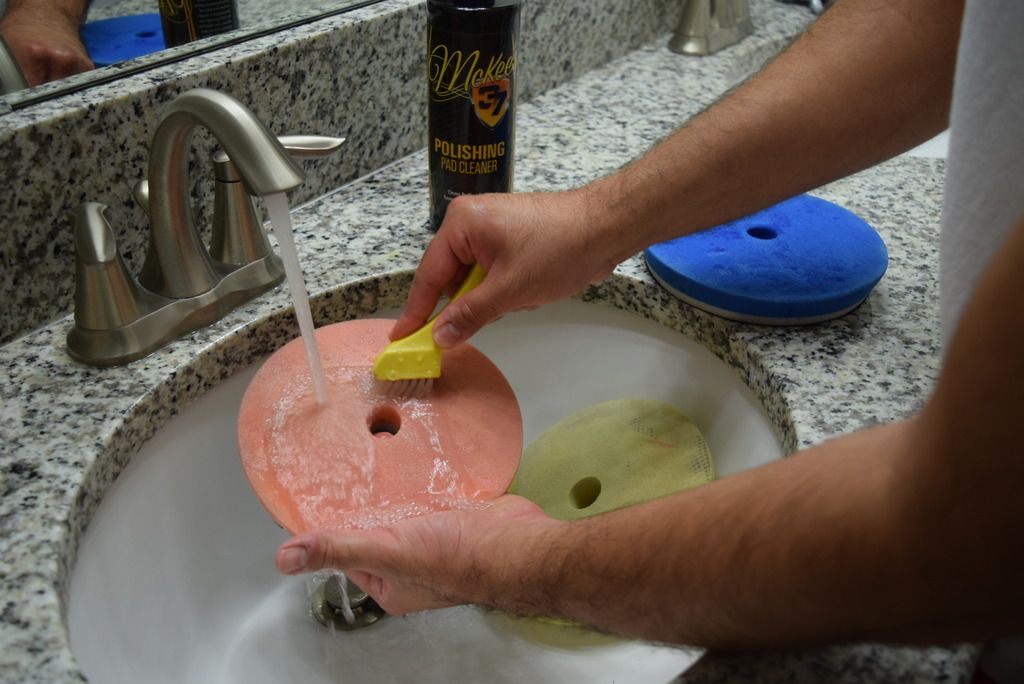
Before
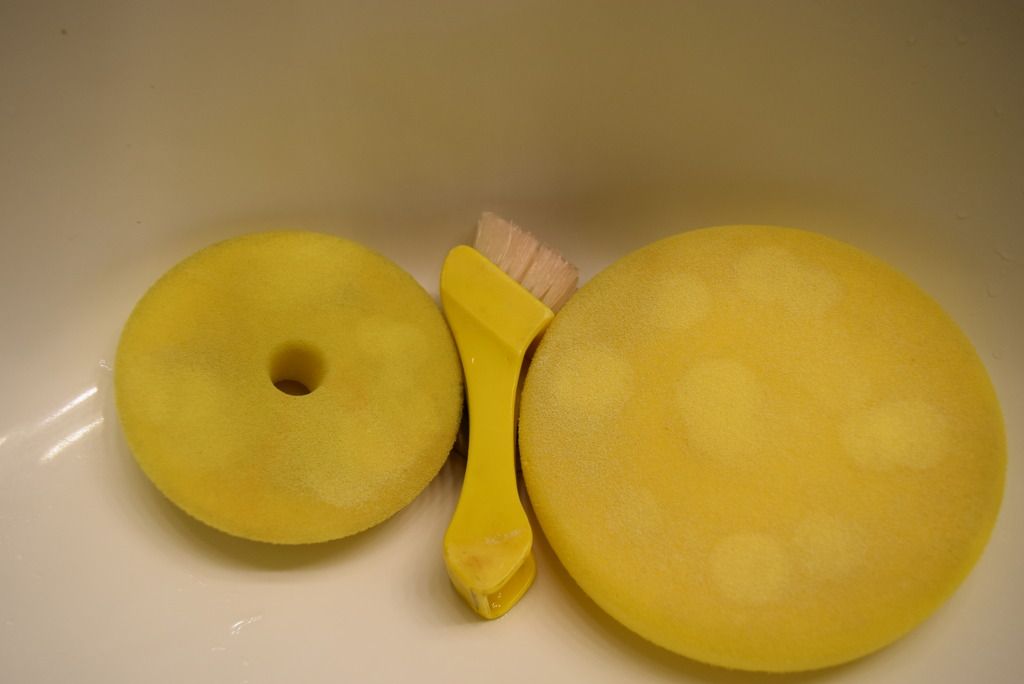
Spraying Polishing pad cleaner.
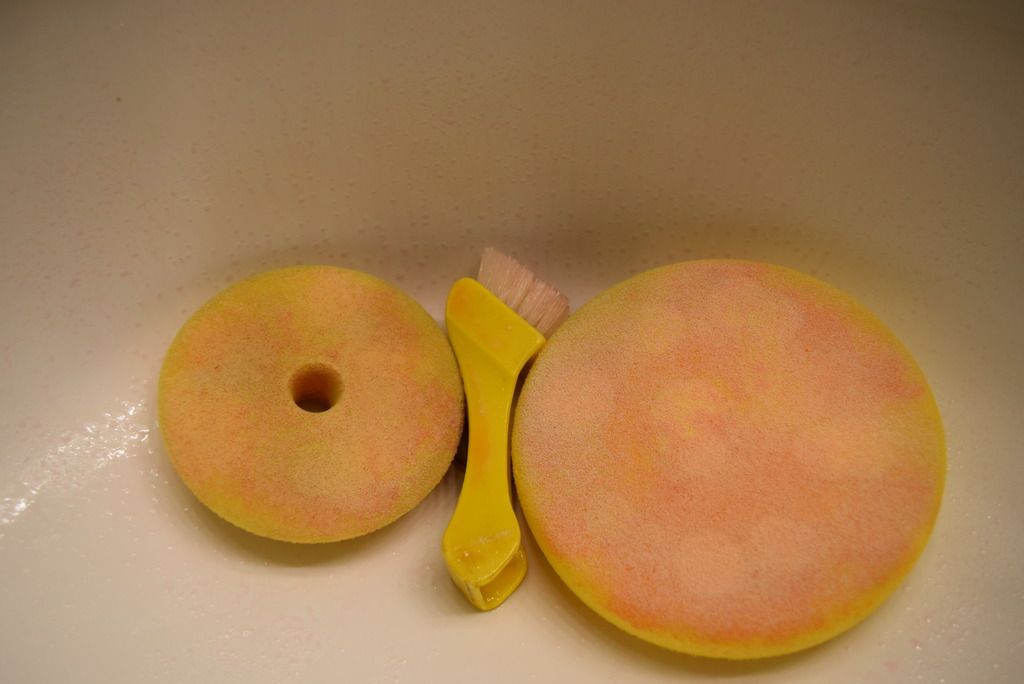
Agitate with soft brush.
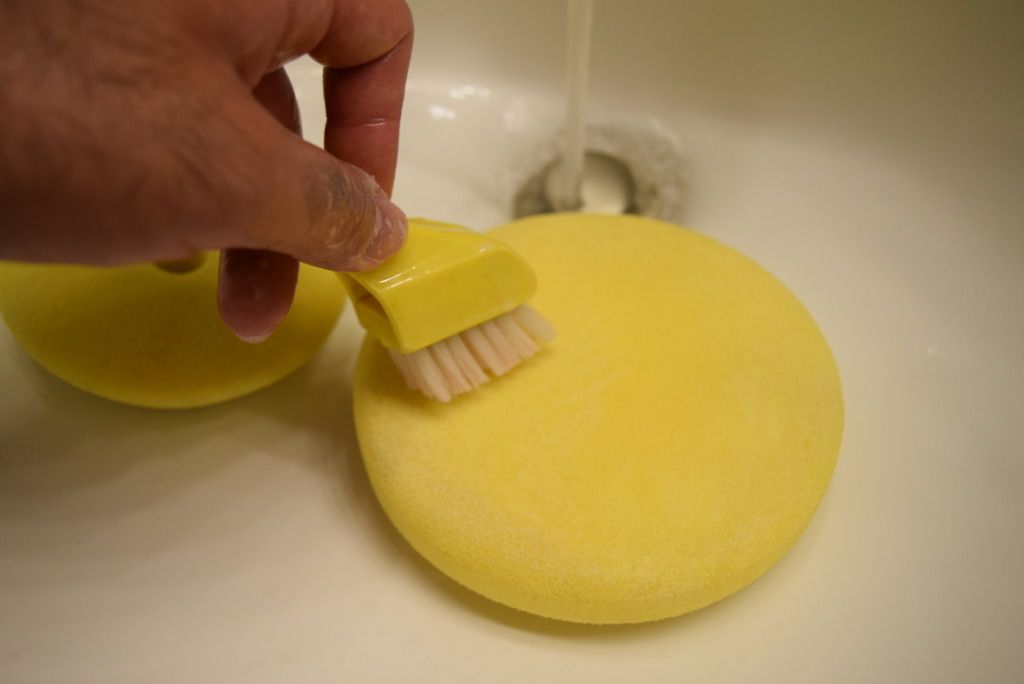
Done. My pads are now restored and ready to be used over and over again.
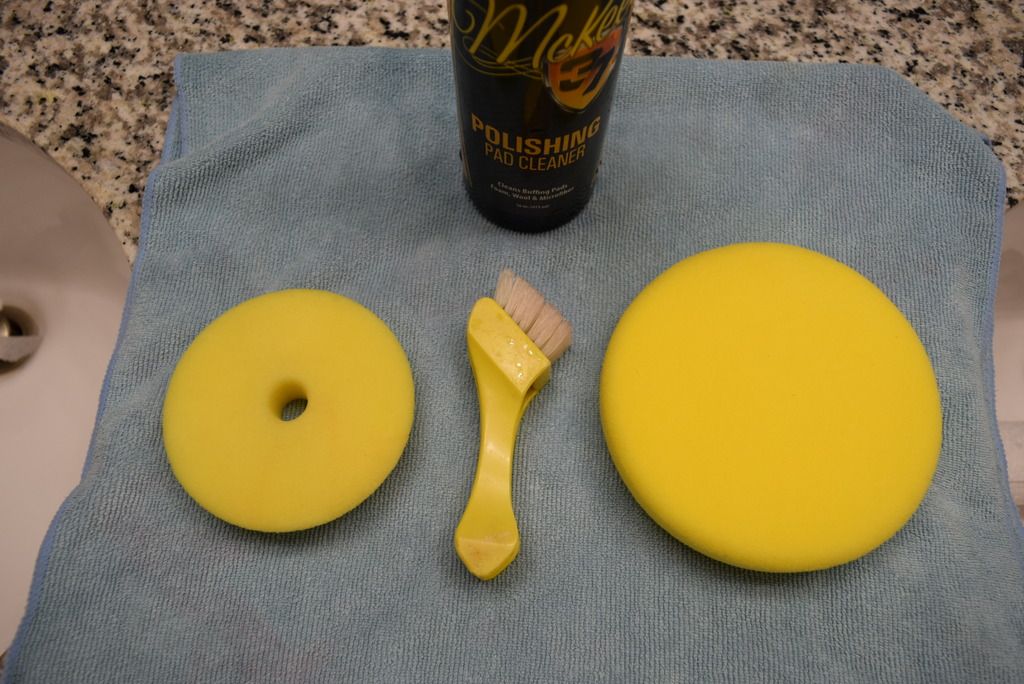
Im rubbing my thumb against the pad, and it feels restored just like new, After using harmful chemicals my pads would feel dry and brittle.

Before And After
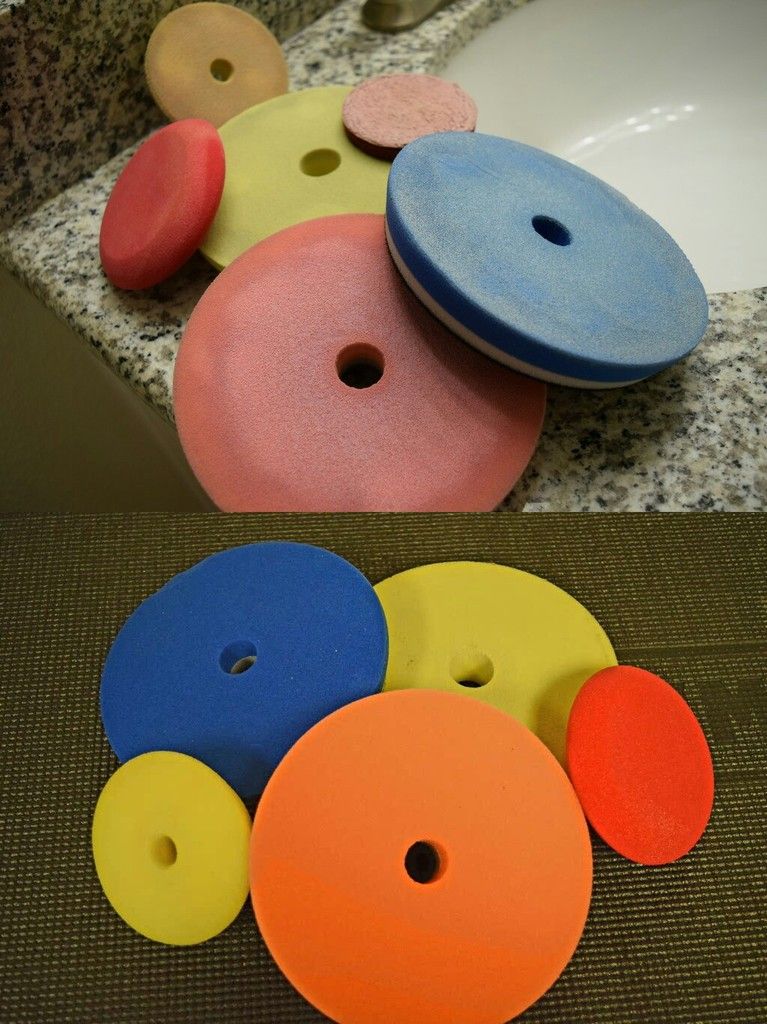

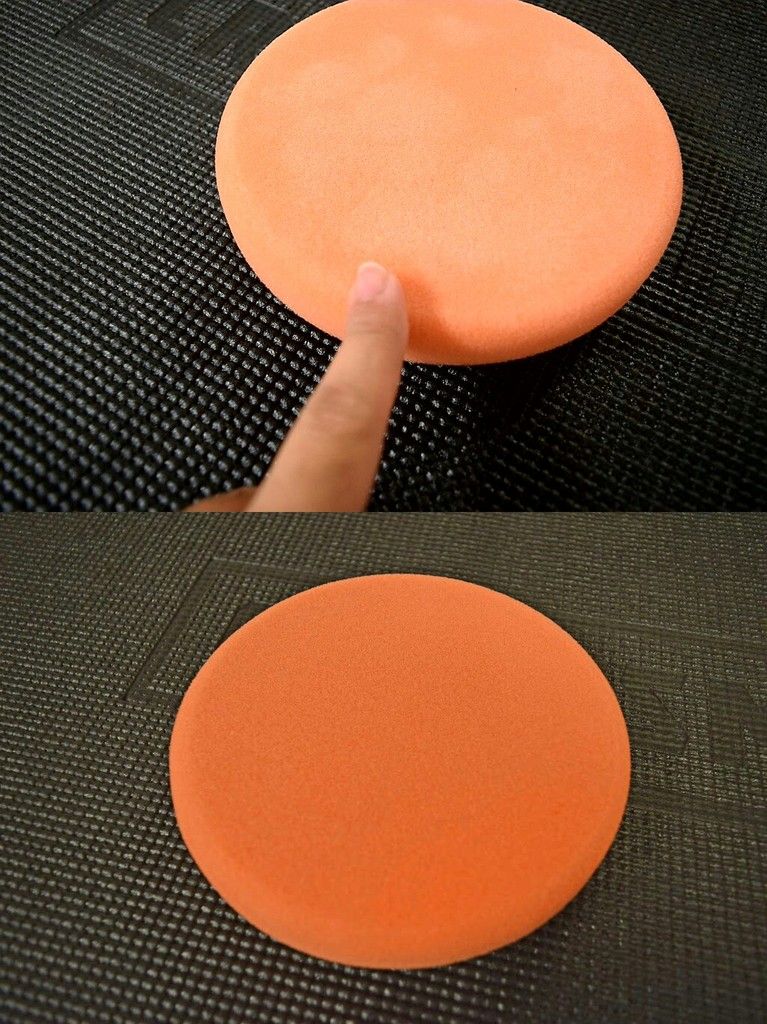
Cleaners VS Polishing Pad Cleaner
After speaking with a chemist about the issues cleaners can cause for your polishing pads, Everything that was shared with me made total sense, I decided to do a "stress test" I was going to test 2 orange Boss pads (I use those alot at my shop) On One I was going to clean with McKee's 37 polishing pad cleaner, and the other I was going to use Dish soap,degreaser. Both pads were only used with 1 machine (G21) and 1 Polish (McKee's 37 Fast Polish) Both pads share the same amount of buffing time. I was going to use my old method of cleaning pads, And the other method was recommended by the chemist.
Old Test Method: Hot Water, Dish Soap + Degreaser
New Test Method: Cool Water, Polishing Pad Cleaner
Can you guess what pad was maintained with what? You guessed right the top pad was maintained with Dish Soap, and Diluted Degreaser that you can find at a dollar brand store. The bottom pad was maintained with McKee's 37 Polishing Pad Cleaner.
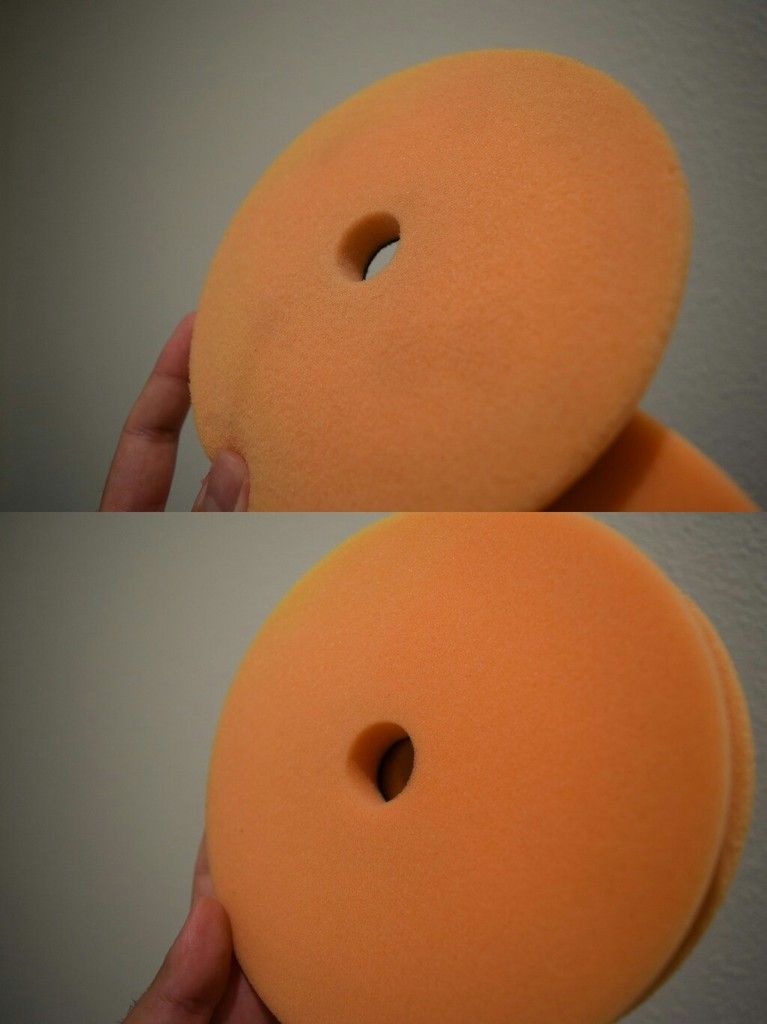
Notice how the top pad lost its color, Also you can see how the face of the pad is starting to shrivel up. The bottom pad still has its original color and feels almost as good as the day I opened the pack. The top pad is the perfect example of what APC/Degreaser does to your hands, It dries them out. Using the dish soap and degreaser it dried the pad out drastically, Not only did it lose its overall color, The pad feels totally different from the other pad that was maintained with polishing pad cleaner.
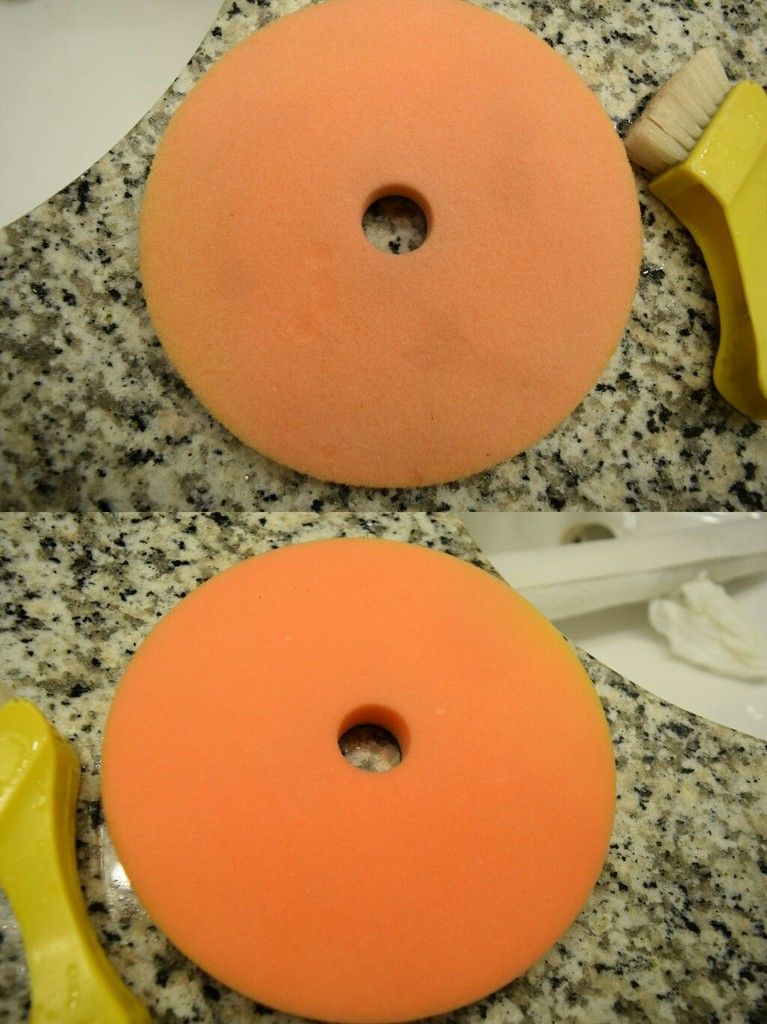
Side By Side
[/FONT]URL=ht[tp://s1194.photobucket.com/user/nextleveldetailer/media/Polishing%20Pads/DSC_0780_zpsi3bxr6iq.jpg.html]
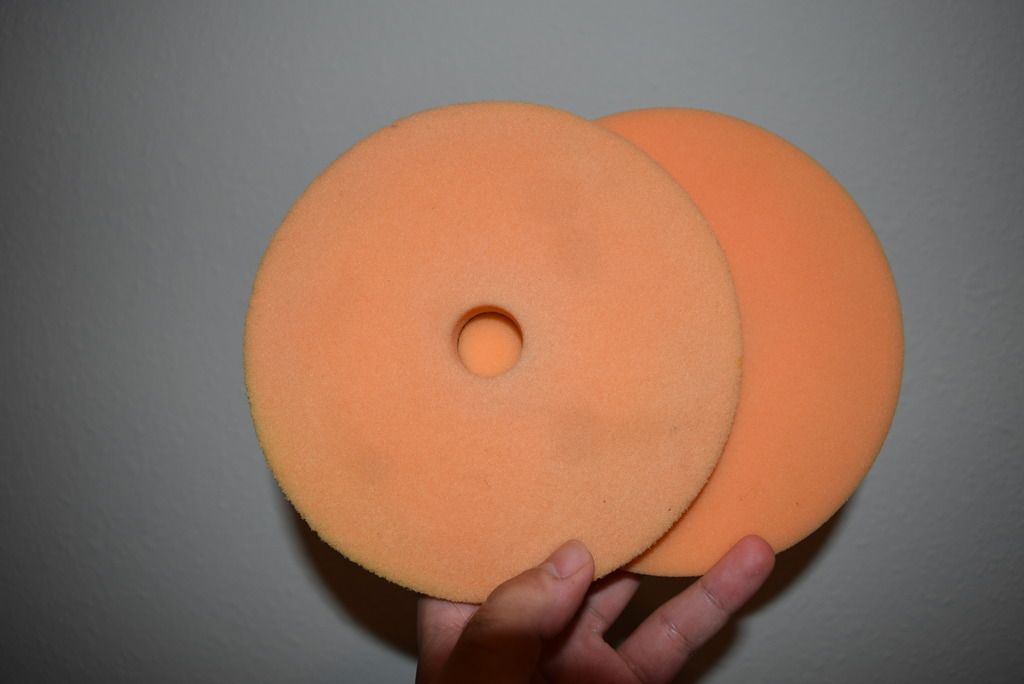 [/URL]
[/URL]
What Not To Do
Like I said above us being detailers we naturally want out pad 100% clean, And sometimes we go to extreme measures and processes to get that done, So I am going to put down a list on what not to do to your polishing pads.
Pressure Washer: No, this will eat and cause deterioration at a much accelerated rate, Even if it doesnt damage it at the start everytime your doing this your stressing your foam out. (Use a hose)
Hot Water: Its natural to want to use really hot water to get all the stains out, However this is not good for the pad, Heat is your pads enemy, And that is the culprit of pad failure, The buffing process makes the pad endure a ton of heat, And now you are stressing the pad even more by cleaning it in hot water. Use cool water to restore the foam and cool the pad down.
Cleaning + Using Too Soon: At my early stages of buffing I only had a handful of pads, And this is very common for a enthusiast to not have hundreds of pads, So when your pad gets gunked up you clean it in the sink, dry it with a microfiber towel to your best ability, and than go back to town! This is hurting your pad and is a one way ticket to paid failure town. Using your pad too fast after you just cleaned Will affect a ton of things. If the pad is still moist/wet understand that the pad is heavier than what it originally is, So now the mechanical energy of the polisher is moving more weight and stressing the pad out way more than normal. This also interferes with your cutting and finishing ability.
Stains On Your Pad: Do not use gas, paint thinner, Knives, to get stains out of your pad, As long as the spent compound, polish is out of your pad the pad will still perform excellent.
Conclusion
I hope you can see how important it is to maintain your pads properly, I hope this opens your eyes as it did mine when I found out, We all make fun of the people that use dish soap to maintain there cars, well this is essentially the same thing, As a pro when I am cleaning about 3-6 pads I use McKee's 37 Polishing Pad Cleaner, At a busy day at the shop when my brother, father, and my self are buffing multiple cars and go through alot of pads, I use McKee's 37 Pad Rejuvenator to clean a bulk of pads, It is priced fair and can get multiple applications out of one jar.

Whatever you are using just make sure it was designed for foam!
I hope you guys enjoyed this, took alot of patience to do the testing.


You might be thinking that tool's are your most expensive investment, But in reality its not, Tools require little maintenance after purchase. As for pads you will always go through more and more. The above photo you will notice a Flex polisher, and pads surrounding. The Flex polisher is $389 the pads I have placed around the polisher add up to a value of $400! and in reality that is a small fraction of all the pads I own, And it is crazy when you stop and think that only 25 pads+ accumulate to that value.
Pads are one of the most important and costly materials a detailer uses. So how you take care of them is vital to longevity and performance.
As a professional detailer I am always looking for ways to cut costs, My concerns with spending more money really cost me more cash in the long run. In my professional career there is nothing more frustrating then a pre mature pad failure. Through my experience I have became to realize that it's how you care for your pads that determines the life span.
Maintaining Pads
There is more to cleaning your pads than "cleaning your pads" We have all been guilty of using, Dish Soap, Degreaser, All Purpose Cleaner. There are even alot of mentions on this very forum about paint thinner. And all of those products will get the job done in cleaning your pads, However these powerful harmful products are actually damaging and degrading your pads with each use. Naturally us being detailers we want everything 100% clean, However we are being counter intuitive, Those stubborn polishing stains are not going to affect polishing performance, However the wrong chemicals, that we are using to remove those stubborn stains damage the foam cell foundation and that will most certainly alter your polishing pad performance and life span.
Ever notice after you use dish soap to strip a car how grabby and squeaky the paint feels? The same affect happens to your polishing pads after using the above cleaners, It makes your pad feel dry, brittle, grabby, and the foam feels squeaky.

The above photo you will see the foam cells magnified, You will notice the honey comb cell pattern, and that is the structural foundation of the pad. All Purpose Cleaners, Degreasers, Dish Soap, Laundry Soap, all load up in the pores and cells of these pads and actually dissolve the pores, And this is a one way ticket to pad failure. Residue from all the cleaners above will linger in the pad and continue to break down as you use it. So now it is taking a beating while getting polished and cleaned.
The Right Chemical For The Job
All soap is not created equally, Using the correct chemical for any maintenance is key, We use car soap and rinseless wash solutions to maintain our paint finish, that was designed and formulated for paint, None of us would ever use laundry soap to wash our car. , However every soap was formulated for a different purpose, We wouldnt use hair shampoo for laundry, Laundry soap for body wash, and dish soap for shampoo, sure it would give us a end result of "clean" however there would be certain things that can potentially cause damage or not work as well.
Have you ever went camping or ran out of shampoo and had to use body wash to clean there hair? Afterwards it leaves you with a very dry and grabby feel, Another great example is using degreaser or all purpose cleaner to wash our hands, afterwards they feel very dry that is why we use hand soap, The same theory goes for polishing pads. Chemist formulate and design every product to do what its intended purpose was for, Polishing pad cleaner is designed to remove compounds, polishes, waxes/sealant, specifically for foam.
Cleaning Your Pads
Not only can the strong chemicals hurt your pads, but the actual way you clean them can degrade them as well.

spray your polishing pad cleaner on your pads, im using McKees 37 Polishing Pad Cleaner.

After you let the product sit on the pads for 20-30 seconds, Get a SOFT brush not a hard brush and agitate the compound/polish
(using a hard brush can cause ripples in the pad)

Using cool/warm water I run the pad under the water while brushing face of the pad with my brush, Ensuring all polish is out of the pad.
(do not use really hot water as this can cause damage to your pad, You want to cool the pad down so the foam cells can expand and get stong again)

Before

Spraying Polishing pad cleaner.

Agitate with soft brush.

Done. My pads are now restored and ready to be used over and over again.

Im rubbing my thumb against the pad, and it feels restored just like new, After using harmful chemicals my pads would feel dry and brittle.

Before And After



Cleaners VS Polishing Pad Cleaner
After speaking with a chemist about the issues cleaners can cause for your polishing pads, Everything that was shared with me made total sense, I decided to do a "stress test" I was going to test 2 orange Boss pads (I use those alot at my shop) On One I was going to clean with McKee's 37 polishing pad cleaner, and the other I was going to use Dish soap,degreaser. Both pads were only used with 1 machine (G21) and 1 Polish (McKee's 37 Fast Polish) Both pads share the same amount of buffing time. I was going to use my old method of cleaning pads, And the other method was recommended by the chemist.
Old Test Method: Hot Water, Dish Soap + Degreaser
New Test Method: Cool Water, Polishing Pad Cleaner
Can you guess what pad was maintained with what? You guessed right the top pad was maintained with Dish Soap, and Diluted Degreaser that you can find at a dollar brand store. The bottom pad was maintained with McKee's 37 Polishing Pad Cleaner.

Notice how the top pad lost its color, Also you can see how the face of the pad is starting to shrivel up. The bottom pad still has its original color and feels almost as good as the day I opened the pack. The top pad is the perfect example of what APC/Degreaser does to your hands, It dries them out. Using the dish soap and degreaser it dried the pad out drastically, Not only did it lose its overall color, The pad feels totally different from the other pad that was maintained with polishing pad cleaner.

Side By Side
[/FONT]URL=ht[tp://s1194.photobucket.com/user/nextleveldetailer/media/Polishing%20Pads/DSC_0780_zpsi3bxr6iq.jpg.html]

What Not To Do
Like I said above us being detailers we naturally want out pad 100% clean, And sometimes we go to extreme measures and processes to get that done, So I am going to put down a list on what not to do to your polishing pads.
Pressure Washer: No, this will eat and cause deterioration at a much accelerated rate, Even if it doesnt damage it at the start everytime your doing this your stressing your foam out. (Use a hose)
Hot Water: Its natural to want to use really hot water to get all the stains out, However this is not good for the pad, Heat is your pads enemy, And that is the culprit of pad failure, The buffing process makes the pad endure a ton of heat, And now you are stressing the pad even more by cleaning it in hot water. Use cool water to restore the foam and cool the pad down.
Cleaning + Using Too Soon: At my early stages of buffing I only had a handful of pads, And this is very common for a enthusiast to not have hundreds of pads, So when your pad gets gunked up you clean it in the sink, dry it with a microfiber towel to your best ability, and than go back to town! This is hurting your pad and is a one way ticket to paid failure town. Using your pad too fast after you just cleaned Will affect a ton of things. If the pad is still moist/wet understand that the pad is heavier than what it originally is, So now the mechanical energy of the polisher is moving more weight and stressing the pad out way more than normal. This also interferes with your cutting and finishing ability.
Stains On Your Pad: Do not use gas, paint thinner, Knives, to get stains out of your pad, As long as the spent compound, polish is out of your pad the pad will still perform excellent.
Conclusion
I hope you can see how important it is to maintain your pads properly, I hope this opens your eyes as it did mine when I found out, We all make fun of the people that use dish soap to maintain there cars, well this is essentially the same thing, As a pro when I am cleaning about 3-6 pads I use McKee's 37 Polishing Pad Cleaner, At a busy day at the shop when my brother, father, and my self are buffing multiple cars and go through alot of pads, I use McKee's 37 Pad Rejuvenator to clean a bulk of pads, It is priced fair and can get multiple applications out of one jar.

Whatever you are using just make sure it was designed for foam!
I hope you guys enjoyed this, took alot of patience to do the testing.